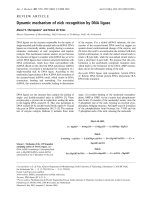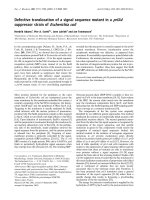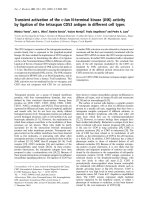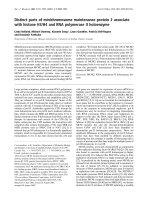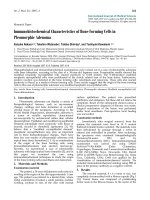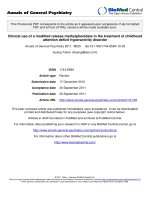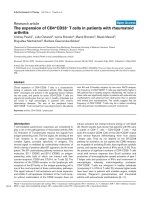Báo cáo y học: "Dynamic activation of bone morphogenetic protein signaling in collagen-induced arthritis supports their role in joint homeostasis and disease" ppsx
Bạn đang xem bản rút gọn của tài liệu. Xem và tải ngay bản đầy đủ của tài liệu tại đây (2.07 MB, 10 trang )
Open Access
Available online />Page 1 of 10
(page number not for citation purposes)
Vol 10 No 5
Research article
Dynamic activation of bone morphogenetic protein signaling in
collagen-induced arthritis supports their role in joint homeostasis
and disease
Melina Daans, Rik JU Lories and Frank P Luyten
Laboratory for Skeletal Development and Joint Disorders, Division of Rheumatology, Department of Musculoskeletal Sciences, Katholieke Universiteit
Leuven, Herestraat 49 box 813, Leuven 3000, Belgium
Corresponding author: Rik JU Lories,
Received: 7 Feb 2008 Revisions requested: 11 Mar 2008 Revisions received: 26 Aug 2008 Accepted: 24 Sep 2008 Published: 24 Sep 2008
Arthritis Research & Therapy 2008, 10:R115 (doi:10.1186/ar2518)
This article is online at: />© 2008 Daans et al.; licensee BioMed Central Ltd.
This is an open access article distributed under the terms of the Creative Commons Attribution License ( />),
which permits unrestricted use, distribution, and reproduction in any medium, provided the original work is properly cited.
Abstract
Introduction Rheumatoid arthritis is a chronic systemic
autoimmune disease affecting peripheral joints and leading to
loss of joint function. The severity and outcome of disease are
dependent on the balance between inflammatory/destructive
and homeostatic or repair pathways. Increasing evidence
suggests a role for bone morphogenetic protein (BMP) signaling
in joint homeostasis and disease.
Methods Activation of BMP signaling in collagen-induced
arthritis as a model of rheumatoid arthritis was studied by
immunohistochemistry and Western blot for phosphorylated
SMAD1/5 at different time points. Expression of different BMP
ligands and noggin, a BMP antagonist, was determined on
synovium and cartilage extracts of arthritic knees, at different
time points, with quantitative polymerase chain reaction. At the
protein level, BMP2 and BMP7 were studied with
immunohistochemistry. Finally, the effect of anti-tumor necrosis
factor-alpha (TNFα) treatment on the expression of BMP2,
BMP7, and growth and differentiation factor-5 (GDF5) in
synovium and cartilage of arthritic knees was investigated.
Results A time-dependent activation of the BMP signaling
pathway in collagen-induced arthritis was demonstrated with a
dynamic and characteristic expression pattern of different BMP
subfamily members in synovium and cartilage of arthritic knees.
As severity increases, the activation of BMP signaling becomes
more prominent in the invasive pannus tissue. BMP2 is present
in cartilage and the hyperplastic lining layer. BMP7 is found in
the sublining zone and inflammatory infiltrate. Treatment with
etanercept slowed down progression of disease, but no change
in expression of GDF5, BMP2, and BMP7 in synovium was
found; in the cartilage, however, blocking of TNFα increased the
expression of BMP7.
Conclusions BMP signaling is dynamically activated in
collagen-induced arthritis and is partly TNFα-independent.
TNFα blocking increased the expression of BMP7 in the
articular cartilage, possibly enhancing anabolic mechanisms.
Different types of source and target cells are recognized. These
data further support a role for BMP signaling in arthritis.
Introduction
Rheumatoid arthritis (RA) is a chronic and systemic autoim-
mune disease that affects mainly the peripheral joints. Synovi-
tis with infiltration of inflammatory cells, synoviocyte
proliferation, and accelerated angiogenesis triggers the forma-
tion of destructive pannus tissue and osteoclast activation that
lead to erosion of cartilage and bone with progressive loss of
joint function [1]. From a molecular point of view, the severity
and prognosis of RA are dependent on the balance between
inflammatory or destructive pathways and homeostatic or
repair pathways [2,3]. Molecular signaling pathways, essential
for tissue development and growth, such as bone morphoge-
netic proteins (BMPs), are likely to play a role in tissue home-
ostasis and repair [4]. However, inappropriate or exaggerated
activation of such pathways may also lead to pathology [5-8].
BMP: bone morphogenetic protein; BSA: bovine serum albumin; CFA: complete Freund's adjuvant; CIA: collagen-induced arthritis; CII: collagen type
II; GDF5: growth and differentiation factor-5; H&E: hematoxylin and eosin; HRP: horseradish peroxidase; NOG: noggin; O/N: overnight; PBS: phos-
phate-buffered saline; PCR: polymerase chain reaction; P-SMAD: phosphorylated Smad family members; RA: rheumatoid arthritis; RT: room temper-
ature; SMAD: Smad family members; TBST: Tris-buffered saline/0.1% Tween; TNFα: tumor necrosis factor-alpha.
Arthritis Research & Therapy Vol 10 No 5 Daans et al.
Page 2 of 10
(page number not for citation purposes)
BMPs are members of the transforming growth factor-beta
superfamily, a group of structurally related growth and differ-
entiation factors. Their pleiotropic effects on different cell
types steer many pre- and postnatal processes, such as cell
differentiation, proliferation, adhesion, motility, and apoptosis
[9-11]. BMPs were originally discovered as proteins that
ectopically induce cartilage and bone formation in vivo [12]
and are important during the embryonic development of artic-
ular joints [13-16]. Almost 30 BMPs are described and classi-
fied into several subgroups according to their structural
similarities [17]. Binding of a dimeric BMP ligand to type I and
type II BMP receptors typically activates a downstream signal-
ing cascade involving either SMAD family member (SMAD)
molecules or mitogen-activated protein kinases. In the classi-
cal and most extensively studied pathway, the receptor-ligand
complex will phosphorylate the intracellular receptor-SMAD1
and -SMAD5 molecules. These will form a complex with com-
mon SMAD4, which translocates to the nucleus, binds to
DNA, and directs the transcription of BMP target genes. BMP
signaling is regulated at different levels: by ligand diversity, by
secreted extracellular BMP antagonists, by inhibitory SMADs,
and by nuclear corepressors and coactivators [18,19].
Different BMPs have been demonstrated in the synovium of
RA patients [20-22] but their function and their target cells are
not yet clear. BMPs have a chondroprotective role in different
animal models of RA [23]. In the present study, we investi-
gated the activation of BMP signaling and expression patterns
of different BMP ligands and antagonists in collagen-induced
arthritis (CIA). CIA is a well-established mouse model of RA,
which develops in susceptible mouse strains following immu-
nization with heterologeous type II collagen (CII) emulsified in
complete Freund's adjuvant (CFA) and shares both immuno-
logical and pathological features with human RA [24]. Our
data highlight the relevance of BMP signaling in the joint and
provide a basis for further studies on the role of specific BMPs
in RA.
Materials and methods
Animal studies
Eight-week-old male DBA/1J mice were purchased from Jan-
vier Laboratories (Le Genest-Saint-Isle, France). All experi-
ments were approved by the Ethics Committee for Animal
Research (Katholieke Universiteit Leuven, Leuven, Belgium).
For induction of arthritis, chicken sternal cartilage CII (Sigma-
Aldrich, Bornem, Belgium) was dissolved at 2 mg/mL in phos-
phate-buffered saline (PBS)/0.1 M acetic acid, stirred over-
night (O/N) at 6°C, and emulsified with an equal volume of
CFA (1 mg/mL) (Sigma-Aldrich). One hundred microliters of
the emulsion (0.1 mg of CII) was injected intradermally at the
base of the tail. At day 21 after immunization, mice received an
intraperitoneal booster injection of 100 μL of CII (2 mg/mL). At
day 25, the onset of arthritis was synchronized by an intraperi-
toneal injection of 100 μL of lipopolysaccharide (500 μg/mL
in PBS) (Sigma-Aldrich) [25]. Mice were sacrificed at different
time points (day 0, 20, 27, 33, 40, and 47 after immunization)
for immunohistochemistry and protein and RNA expression
assays. In additional experiments, mice were injected daily
with 100 μL of soluble tumor necrosis factor-alpha (TNFα)
receptor etanercept/PBS (250 μg/mL) (Wyeth Pharmaceuti-
cals, Louvain-la-Neuve, Belgium) intraperitoneally (or PBS
alone as negative control) from day 29 onwards. The severity
score was determined daily according to the scoring system
of Backlund and colleagues [26]. Mice were sacrificed at day
35.
RNA extraction, cDNA synthesis, and quantitative
polymerase chain reaction analysis of synovium and
cartilage samples
At each time point and at the end of the TNFα blocking exper-
iment, synovium and cartilage samples were dissected, sepa-
rated, and used for RNA extraction. RNA was isolated using a
Nucleospin RNAII kit (Macherey-Nagel, Düren, Germany) and
reverse-transcribed using a Revert-Aid H Minus First strand
cDNA synthesis kit (Fermentas, St. Leon-Rot, Germany)
according to the manufacturers' instructions. For quantitative
analysis, real-time polymerase chain reaction (PCR) was per-
formed in duplicate using the Rotor-gene 6000 detection sys-
tem (Corbett Research, Westburg, Leusden, The
Netherlands). Gene expression of mouse BMP2, BMP4,
BMP6, BMP7, growth and differentiation factor-5(GDF5),
Noggin (NOG), and TNF
α
were studied using assay-on-
demand primer/probe sets (Applied Biosystems, Lennik, Bel-
gium). Expression was normalized to mouse housekeeping
gene GAPDH (glyceraldehydes-3-phosphate dehydroge-
nase) using the comparative threshold method [27]. In kinetic
experiments, data were further normalized to baseline levels.
Protein extraction and Western blot analysis of whole
knees
At each time point, three sets of three pooled knees were used
for protein extraction. Whole knees were weighed and homog-
enized (CAT homogenizer X120; CAT Ingenieurbüro M. Zip-
perer GmbH, Staufen, Germany) in 1 mL of cell extraction
buffer (Biosource Europe, Nivelles, Belgium) supplemented
with 5% Proteinase Inhibitor Cocktail (Sigma-Aldrich) and 1
mM PMSF (phenylmethylsulfonyl fluoride) (Sigma-Aldrich).
Protein extracts were normalized to wet weight in an appropri-
ate volume of cell extraction buffer. Samples were analyzed
under reduced conditions (0.1 M DTT [1,4-dithiothreitol]).
Samples were boiled for 5 minutes at 95°C, chilled on ice, and
loaded onto a 4% to 12% Bis-Tris gel (Invitrogen Corporation,
Carlsbad, CA, USA). Electrophoresis was carried out into a
commercially available running buffer (NuPage MES SDS
Running buffer; Invitrogen Corporation) at 130 V for 10 min-
utes in the beginning, followed by 25 minutes at 200 V. Pro-
teins were transferred on a prewet PVDF (polyvinylidene
difluoride) membrane (Millipore S.A./N.V., Brussels, Belgium)
for 70 minutes at 30 V in a transfer buffer containing 0.4 M gly-
cine, 0.5 M Tris base, 0.01 M SDS, and 200 mL/L methanol.
Available online />Page 3 of 10
(page number not for citation purposes)
Nonspecific binding sites were blocked in Tris-buffered saline/
0.1% Tween (TBST) (wash buffer) with 5% milkpowder (Blot-
toA) (Santa Cruz Biotechnology, Inc., Santa Cruz, CA, USA)
for 1 hour at room temperature (RT). Blots were then probed
O/N at 4°C with polyclonal antibody against phosphorylated
SMAD1/5 (P-SMAD1/5) or SMAD5 (Cell Signaling Technol-
ogy, Inc., Danvers, MA, USA) (1:1,000 in TBST/5% bovine
serum albumin [BSA]) and thereafter incubated with an appro-
priate horseradish peroxidase (HRP)-conjugated secondary
antibody (Jackson ImmunoResearch Laboratories, Inc., West
Grove, PA, USA) at a dilution of 1:5,000 in TBST/5% milk-
powder for 1 hour at RT. For detection, a chemiluminescent
substrate (Western Lightning; PerkinElmer Life and Analytical
Sciences, Inc., Waltham, MA, USA) was applied on the mem-
brane. Blots were visualized using an LAS-3000 mini CCD
(charge-coupled device) camera using an exposure time of 15
minutes. Densitometry measurements were done using digital
image densitometry analysis (ImageJ; National Institutes of
Health, Bethesda, MD, USA). As positive controls, mouse
mesenchymal progenitor C2C12 cells were stimulated with
recombinant BMP2 (300 ng/mL for 30 minutes). As negative
controls, blots were incubated with secondary antibody alone
(data not shown).
Immunohistochemistry
Knees and ankles were dissected, formaldehyde/PBS-fixed
O/N, decalcified with Decal (3 days at RT) (Serva, Heidelberg,
Germany) or EDTA (ethylenediaminetetraacetic acid) (0.5 M in
PBS, pH 7.5) (10 changes at 4°C), and embedded in paraffin.
For immunohistochemistry, paraffin sections (5 μm thick) were
deparaffinized with Histo-Clear (National Diagnostics, Atlanta,
GA, USA) and methanol. For antigen retrieval, sections were
incubated 2 hours at RT in 0.1 M sodium citrate/0.1 M citric
acid. Endogenous peroxidase was quenched by incubating
the slides for 10 minutes in 3% H
2
O
2
in water (BMP7 and P-
SMAD1/5) or 3% H
2
O
2
in methanol (BMP2). Sections were
washed three times in PBS/0.1% Triton (BMP7 and P-
SMAD1/5) or in TBST (wash buffer) (BMP2) and blocked 30
minutes at RT in 20% donkey serum (BMP7, BMP2) or 20%
goat serum (P-SMAD1/5) in wash buffer and were incubated
O/N at 4°C with primary antibody at a final concentration of 10
μg/mL chicken anti-BMP7 (Pfizer Inc, New York, NY, USA), 2
μg/mL goat anti-BMP2 (Santa Cruz Biotechnology, Inc.), 1:50
dilution of rabbit anti-P-SMAD1/5 (Cell Signaling Technology,
Inc.) or with isotype control (chicken, goat, and rabbit IgG)
(Santa Cruz Biotechnology, Inc.) or serum (Dako, Glostrup,
Denmark) at an appropriate concentration in wash buffer. Sec-
tions were then washed three times with wash buffer and incu-
bated for 30 minutes at RT with secondary antibody. For
BMP7 immunostaining, the secondary antibody was an HRP-
conjugated anti-chicken (Jackson ImmunoResearch Europe
Ltd, Newmarket, Suffolk, UK) diluted 1:100. For BMP2 immu-
nostaining, a biotinylated donkey anti-goat at 1:400 dilution
was used, followed by streptavidin anti-HRP (LSAB kit) (Dako)
(30 minutes at RT). For P-SMAD1/5 immunostaining, an ABC
kit (Vecta stain rabbit IgG [Vector laboratories Ltd., Peterbor-
ough, UK]) was used for signal amplification. Liquid DAB (3,3'-
diaminobenzidine) substrate chromogen system (Dako) was
used as a peroxidase substrate. Sections were counterstained
with hematoxylin. Adjacent sections were stained with hema-
toxylin and eosin (H&E). GDF5 immunohistochemistry was not
performed on these samples as we found that different com-
mercially available antibodies showed a lack of specificity.
Statistical analysis
Where appropriate (n > 3), results were analyzed with SPSS
15.0 (SPSS Inc., Chicago, IL, USA) with the unpaired non-par-
ametric Mann-Whitney U test. Statistically significant differ-
ences were defined as P values of less than 0.05.
Results
Activation of bone morphogenetic protein signaling in
collagen-induced arthritis
Activation of BMP signaling during the course of CIA was vis-
ualized at different time points by immunohistochemistry for P-
SMAD1/5 (Figure 1b,d,f,h). Histo-morphological scoring of
adjacent H&E-stained sections was used to assess the sever-
ity of disease (Figure 1a,c,e,g,i). In the initial phase of CIA
(exsudate score 1 and infiltration and pannus formation score
0), only a few P-SMAD1/5-positive cells were visible, mostly in
the lining layer of the synovium (Figure 1b). With increasing
severity, characterized by infiltration of inflammatory cells and
synovial hyperplasia (exsudate score 1, infiltration score 3, and
pannus formation score 1), P-SMAD1/5-positive cells became
apparent in the subintimal zone of the synovium. Also, a few
blood vessels and articular chondrocytes showed nuclear P-
SMAD1/5 staining (Figure 1d–f). Eventually, in the destructive
phase (pathology exsudate score 2, infiltration score 3, and
pannus formation score 2), P-SMAD1/5-positive cells were
identified in the invading pannus tissue (Figure 1h). In contrast,
healthy knees showed almost no P-SMAD1/5-positive cells
(data not shown) and IgG controls were negative (Figure 1j).
Activation of BMP signaling in CIA was further semi-quantified
by Western blot on pooled protein extracts from whole knees
at different time points (day 0, 20, 27, 33, 40, and 47 of the
experiment). Positive controls were obtained by stimulating
C2C12 cells with recombinant BMP2 (300 ng/mL) for 30 min-
utes. Mouse knee extracts (three per time point, each pooled
from three different knees) were normalized to wet weight. A
specific 60-kDa band was found in all samples (Figure 2a).
Negative controls showed no band of this size (data not
shown). C2C12 cells stimulated with BMP2 had a higher
expression of P-SMAD1/5 than unstimulated cells (Figure 2b).
We further studied the relative amount of phosphorylated and
therefore activated SMAD1/5 as compared with total SMAD5
levels. Densities of P-SMAD1/5 and SMAD5 bands of mouse
samples were quantified using digital image analysis densit-
ometry software. (ImageJ, National Institutes of Health,
Bethesda, MD, USA) Normalized density of P-SMAD1/5
Arthritis Research & Therapy Vol 10 No 5 Daans et al.
Page 4 of 10
(page number not for citation purposes)
bands per time point was consistently upregulated (three sam-
ples versus three samples) from day 33 onwards as compared
with baseline (Figure 2c). These semi-quantitative Western
blot data thus corroborated our immunohistochemical results,
supporting more active BMP signaling in the joint as CIA
progresses.
Kinetics of bone morphogenetic protein ligands in
collagen-induced arthritis – mRNA level
Quantitative PCR for different BMP ligands and BMP antago-
nist NOG in both synovium and cartilage extracts (three sets
per time point, extracts from two mice pooled per set) showed
a dynamic expression pattern with upregulation or downregu-
lation of these molecules during the course of CIA (day 0, 20,
27, 33, and 40) as compared with healthy controls (Figure 3).
As expected, expression of TNF
α
in the synovium gradually
increased during the course of the disease process. BMP7
was upregulated with peak expression around day 20. The
expression levels of BMP2, BMP4, BMP6, and NOG were
stable around day 20 and decreased gradually, in contrast to
GDF5 expression, which was downregulated abruptly around
day 20. As gene expression levels are normalized to a house-
keeping gene, they are also likely to be influenced by the
increased number of cells in the synovium. In the articular car-
tilage, an increase in TNF
α
was visualized, though to a milder
extent, but we found a striking increase in GDF5 expression,
whereas the other molecules showed a more or less stable
expression pattern. At day 40, BMP2 was very mildly upregu-
lated in the articular cartilage. Again, due to normalization,
expression levels are likely to be influenced by the decreased
number of cells in the cartilage, due to chondrocyte cell death.
Kinetics of bone morphogenetic protein ligands in
collagen-induced arthritis – protein level
The gene expression data prompted us to further study BMP2
and BMP7 protein levels in the arthritic joint. These prototype
BMPs belong to different subfamilies preferentially binding to
distinct type I and type II receptor complexes. Immunohisto-
chemical analysis of affected mouse knees revealed BMP2
expression predominantly in the hyperplastic lining layer of
synovium and in the articular cartilage (Figure 4b,h). BMP2
was less expressed but still present in some cells in the subin-
timal zone (Figure 4d,f). The BMP7 staining pattern in mouse
knee joint was influenced by disease severity. Mild inflamma-
tion (Figure 5a) was associated with discrete BMP7 staining
in the lining layer of synovium (Figure 5b) and in superficial
chondrocytes in the articular cartilage (Figure 5b). With
increasing severity (Figure 5c,e), BMP7 positivity became
more pronounced in the lining layer and subintima (Figure
5d,f). Eventually, in the destructive phase (Figure 5g), BMP7
positivity appeared more and more in the subintima, away from
the lining layer (Figure 5h).
Effect of tumor necrosis factor-alpha blocking on bone
morphogenetic protein expression levels in collagen-
induced arthritis
As BMP expression was recently reported in the human TNF
transgenic mouse model, we further investigated the effect of
blocking TNFα on expression of BMPs in synovium and carti-
Figure 1
Activation of bone morphogenetic protein signaling in the mouse knee during collagen-induced arthritisActivation of bone morphogenetic protein signaling in the mouse knee
during collagen-induced arthritis. Immunohistochemistry for P-SMAD1/
5 in the initial phase (a, b), with increasing severity (c-f), and in the
destructive phase of collagen-induced arthritis (g, h) and IgG control
(j) is shown. Scoring was done on sections stained with hematoxylin
and eosin (a, c, e, g, i). Boxes indicate areas that are magnified in P-
SMAD1/5 stainings (b, d, f, h). Arrows indicate P-SMAD1/5-positive
cells, and arrowheads indicate P-SMAD1/5-positive blood vessels.
Bars = 200 μm (a, c, e, g, i), 50 μm (d, f, h), and 25 μm (b). P-SMAD,
phosphorylated Smad family members; SMAD, Smad family members.
Available online />Page 5 of 10
(page number not for citation purposes)
lage, using daily intraperitoneal injections of etanercept or
PBS (as control) during clinically apparent CIA (n = 9 mice per
group). Six-day treatment reduced severity of arthritis, as
shown by the cumulative severity scores (Figure 6a). At end-
point, synovium and cartilage were collected and mRNA
expression levels of BMP2, BMP7, and GDF5 were compared
between the two groups. In the synovium, expression levels of
BMP2, BMP7, and GDF5 were not significantly changed. In
cartilage, however, etanercept treatment raised the expression
levels of BMP7 significantly (P = 0.003). BMP2 and GDF5
expression was not affected (Figure 6b). Immunohistochemis-
try confirmed the increased levels of BMP7 in the cartilage
(Figure 6c).
Discussion
In the present study, we demonstrated a dynamic activation of
the BMP signaling pathway, as detected by P-SMADs, in a
mouse model of RA, CIA. The activation pattern is dependent
on the stage of disease, starting, in the initial phase, at the syn-
ovial lining layer, gradually shifting toward the subintimal
region and eventually, in the destructive phase, persisting in
pannus tissue. Moreover, similar dynamic expression levels
were shown for different BMP ligands in CIA. A more extensive
study of BMP2 and BMP7, different BMP subfamily members,
revealed for both BMPs a distinct and dynamic pattern. In con-
trast to BMP2, which is restricted mainly to the synovial lining
layer and articular cartilage, BMP7 resembles the P-SMAD1/
5 positivity pattern very closely (Figure 1). Upon TNF block-
ade, the expression of BMP7 was increased in the articular
cartilage of affected joints, whereas in the synovium the
expression levels of BMP2, BMP7, and GDF5 were
unchanged, suggesting that at least part of the regulation of
BMP expression is TNF-independent. This suggests that,
although some BMPs are upregulated under inflammatory
conditions, other autocrine and paracrine mechanisms may be
important and may sustain BMP expression during the arthritic
disease process [3,28]. In addition, the upregulation of BMP7
seen after anti-TNF treatment, which has an inhibitory effect on
cartilage and bone destruction, supports an anabolic effect of
TNF blockage. Until now, this association was shown with the
Wnt pathway in arthritic mice, in which inhibition of TNF
decreased the expression of Dickkopf, a Wnt antagonist,
known for its neutralizing effect on anabolic mechanisms while
supporting catabolic pathways of joint destruction [29], and
Figure 2
Quantification of P-SMAD1/5 expression during collagen-induced arthritis (CIA) by Western blotQuantification of P-SMAD1/5 expression during collagen-induced arthritis (CIA) by Western blot. (a) Western blot for P-SMAD1/5 and SMAD5 on
mouse whole knee extracts at different time points in CIA, normalized to wet weight (n = 3 sets of pooled knees per time point). (b) Positive control
of Western blot for P-SMAD1/5 and SMAD5 on C2C12 cells unstimulated or stimulated with bone morphogenetic protein-2 (BMP2) (300 ng/mL)
for 30 minutes. Ten micrograms of protein was loaded. (c) Analysis of the activation of the BMP signaling pathway, which was measured as the
inverted density of P-SMAD1/5 bands (normalized to density of SMAD5 bands) (n = 3 sets of 3 pooled knees per time point). Data are presented as
mean ± standard deviation. P-SMAD, phosphorylated Smad family members; SMAD, Smad family members.
Arthritis Research & Therapy Vol 10 No 5 Daans et al.
Page 6 of 10
(page number not for citation purposes)
with melanoma inhibitory activity in RA patients, a chondro-
cyte-specific molecule with anabolic characteristics, which
has a decreased expression under pro-inflammatory cytokine
conditions [30].
Results of earlier studies on BMP expression in RA already
speculated on a potential role for BMPs in RA. Our group
showed an increased expression of BMP2 and BMP6 in the
synovium of RA patients and illustrated their association with
apoptosis of synoviocytes [20]. BMP4 and BMP5, however,
are reduced in the synovium of RA patients as compared with
healthy patients [21]. BMP7 has been demonstrated in the
synovial fluid of RA patients and levels are correlated with
severity of disease [31]. Marinova-Mutafchieva and colleagues
[22] observed BMP type Ia (activin-like receptor kinase-3)
receptor-positive mesenchymal cells in the synovium of RA
patients, and recently we described different BMP target cells,
including mostly fibroblast-like synoviocytes and the vascular-
perivascular niche, in synovial biopsies of RA patients [28]. An
effective treatment of arthritis resulted in an overall reduction
of active BMP signaling. However, the pathway remained
active and the relative number of P-SMAD1/5-positive cells
did not change, suggesting that indeed part of BMP regulation
is inflammation-independent.
Animal models of arthritis are increasingly used to address the
role of BMPs in disease pathogenesis. Our group previously
studied the role of BMP signaling in joint homeostasis and
repair by modulating the BMP signaling pathway in different
mouse models of chronic arthritis [23]. NOG haploinsuffi-
ciency provided protection for articular cartilage against
destruction in methylated BSA-induced arthritis and delayed
the progression from cartilage to bone formation in a mouse
model of spontaneous ankylosing enthesitis [23] by enhancing
BMP signaling. Blaney Davidson and colleagues [32] showed
that BMP2 is associated with cartilage protection, chondro-
genesis, and osteophyte formation in an animal model of oste-
oarthritis, and Badlani and colleagues [33] demonstrated that
BMP7 protected the articular cartilage in a rabbit model of
osteoarthritis, confirming the in vitro pro-anabolic and anti-cat-
abolic properties of BMP7 as proposed by Chubinskaya and
colleagues [34] and Fan and colleagues [35]. Overexpression
of NOG rendered the cartilage more vulnerable in two mouse
models of destructive arthritis (methylated BSA and CIA) [23]
and inhibited the onset and progression of remodeling arthritis
[8].
In contrast, in these overexpression or genetic models, we
have not seen detectable differences in synovitis [23].
Recently, Bobacz and colleagues [36] demonstrated a differ-
ential expression of GDF5 and BMP7 in articular cartilage and
synovium of hTNFtg mice. They found an increased expression
of BMP7 and GDF5 in the synovium of hTNFtg mice along
with a decrease of both genes in articular cartilage. Based on
Figure 3
Quantitative polymerase chain reaction of different bone morphogenetic protein (BMP) ligands in synovium and cartilage during collagen-induced arthritisQuantitative polymerase chain reaction of different bone morphogenetic protein (BMP) ligands in synovium and cartilage during collagen-induced
arthritis. Relative expression of BMP subfamily members BMP2 and BMP4 (green), BMP6 and BMP7 (red), GDF5 (dashed blue), and noggin
(black) (upper panel) and TNF
α
(lower panel) at different time points in collagen-induced arthritis synovium (left) and cartilage (right) towards day 0,
no immunisation. Expression was normalized to GAPDH. (n = 3 sets of 2 pooled mice per time point.) Data are presented as mean relative expres-
sion. GAPDH, glyceraldehydes-3-phosphate dehydrogenase; GDF5, growth and differentiation factor-5; TNFα, tumor necrosis factor-alpha.
Available online />Page 7 of 10
(page number not for citation purposes)
their in vitro data, they concluded that a decrease in the carti-
lage could compromise cartilage repair while an increase of
BMP7 and GDF5 in the synovium might contribute to synovial
hypertrophy. However, Steenvoorden and colleagues [37]
showed that transforming growth factor-beta induced an epi-
thelial-mesenchymal transition-like phenomenon, which appar-
ently precedes synovial hypertrophy, and which can be
inhibited in vitro by adding BMP7. Contrasting data also exist
on the function of BMP7 in other disease models. In inflamma-
tory bowel disease [38] and acute renal failure [39], BMP7
treatment reduces the severity of the pathogenesis and favors
healing. BMP7 inhibits tumor growth in some forms of cancer
[40]. In contrast, BMP7 can promote cell invasion and tumor
growth [41] and directs cancer to metastasis [42,43] or exerts
malignant fibrinogenic effects [44].
Conclusion
The data presented reveal that BMP signaling is activated dur-
ing the course of CIA, following a specific pattern, and may be
partly independent of TNFα. Furthermore, TNF blocking possi-
bly enhances repair mechanisms via upregulation of BMP7.
Our data also confirm that different cells in the synovium and
cartilage are a target for BMP signaling. Taken together, the
current data suggest a chondroprotective effect of BMPs on
articular cartilage, but the biological effect of different BMPs in
distinct synovial compartments may be more complex and fur-
ther functional studies are warranted.
Figure 4
Presence of bone morphogenetic protein-2 (BMP2) during collagen-induced arthritisPresence of bone morphogenetic protein-2 (BMP2) during collagen-
induced arthritis. Immunohistochemistry in the initial phase (a, b), with
increasing severity (c-f), and in the destructive phase of collagen-
induced arthritis (g, h) is shown. Severity scoring was done on sections
stained with hematoxylin and eosin. Boxes indicate areas that are mag-
nified in BMP2 stainings. Arrows indicate BMP2-positive cells in syn-
ovium. Bars = 200 μm (a, c, e, g) and 25 μm (b, d, f, h).
Figure 5
Presence of bone morphogenetic protein-7 (BMP7) during collagen-induced arthritisPresence of bone morphogenetic protein-7 (BMP7) during collagen-
induced arthritis. Immunohistochemistry in the initial phase (a, b), with
increasing severity (c-f), and in the destructive phase of collagen-
induced arthritis (g, h) is shown. Severity scoring was done on sections
stained with hematoxylin and eosin. Boxes indicate areas that are mag-
nified in BMP7 stainings. Arrows indicate BMP7-positive cells in syn-
ovium, and arrowheads indicate BMP7-positive cells in articular
cartilage. Asterisk indicates gradual clearing of the synovial lining layer.
Bars = 200 μm (a, c, e, g), 50 μm (b, d), and 25 μm (f).
Arthritis Research & Therapy Vol 10 No 5 Daans et al.
Page 8 of 10
(page number not for citation purposes)
Competing interests
The authors declare that they have no competing interests.
Authors' contributions
MD performed and analyzed the experiments. RJUL and FPL
participated in the design and coordination of the study,
helped to draft the manuscript, and gave their final approval of
the version to be published. All authors read and approved the
final manuscript.
Authors' information
MD is the recipient of a fellowship from the Institute for the
Promotion of Innovation through Science and Technology in
Flanders (IWT Vlaanderen). RJUL is the recipient of a postdoc-
toral fellowship from the Research Foundation Flanders.
Acknowledgements
The authors thank Ann Hens for her technical support. This work was
funded by the Institute for the Promotion of Innovation through Science
and Technology in Flanders (IWT Vlaanderen), the Research Foundation
Flanders (FWO Vlaanderen) (grant G.0390.03), a GOA grant from KU
Leuven, and a Bristol-Meyers Squibb EULAR Young Investigator Award
to RJUL.
References
1. Firestein GS: Evolving concepts of rheumatoid arthritis. Nature
2003, 423:356-361.
2. Feldmann M, Brennan FM, Maini RN: Rheumatoid arthritis. Cell
1996, 85:307-310.
3. Luyten FP, Lories RJ, Verschueren P, de Vlam K, Westhovens R:
Contemporary concepts of inflammation, damage and repair
Figure 6
Effect of tumor necrosis factor-alpha blocking on bone morphogenetic protein (BMP) expression levels in collagen-induced arthritisEffect of tumor necrosis factor-alpha blocking on bone morphogenetic protein (BMP) expression levels in collagen-induced arthritis. (a) Cumulative
severity scores of mice treated with phosphate-buffered saline (PBS) (solid line) or etanercept (dashed line) (n = 9 animals per group). Data are
shown as total group scores at each time point. (b) Quantitative polymerase chain reaction of BMP2 (left), BMP7 (middle), and GDF5 (right) on syn-
ovium (upper) and cartilage (lower) of mice treated with PBS or etanercept (n = 9 animals per group). Relative expression is normalized to GAPDH.
Data are presented as median, quartile, and percentile (Mann-Whitney U test *P < 0.05). (c) Expression of BMP7 on the protein level in articular car-
tilage from mice treated with PBS or etanercept. Immunohistochemistry for BMP7 on ankle sections. Insets represent higher-magnification views
(3:1) of the boxed areas. Bar = 50 μm. GAPDH, glyceraldehydes-3-phosphate dehydrogenase; GDF5, growth and differentiation factor-5.
Available online />Page 9 of 10
(page number not for citation purposes)
in rheumatic diseases. Best Pract Res Clin Rheumatol 2006,
20:829-848.
4. Lories RJ, Luyten FP: Bone morphogenetic protein signaling in
joint homeostasis and disease. Cytokine Growth Factor Rev
2005, 16:287-298.
5. Sancho E, Batlle E, Clevers H: Signaling pathways in intestinal
development and cancer. Annu Rev Cell Dev Biol 2004,
20:695-723.
6. Hsu MY, Rovinsky S, Penmatcha S, Herlyn M, Muirhead D: Bone
morphogenetic proteins in melanoma: angel or devil? Cancer
Metastasis Rev 2005, 24:251-263.
7. Yoshikawa H, Nakase T, Myoui A, Ueda T: Bone morphogenetic
proteins in bone tumors. J Orthop Sci 2004, 9:334-340.
8. Lories RJ, Derese I, Luyten FP: Modulation of bone morphoge-
netic protein signaling inhibits the onset and progression of
ankylosing enthesitis. J Clin Invest 2005, 115:1571-1579.
9. Hogan BL: Bone morphogenetic proteins in development.
Curr Opin Genet Dev 1996, 6:432-438.
10. Ferguson CM, Miclau T, Hu D, Alpern E, Helms JA: Common
molecular pathways in skeletal morphogenesis and repair.
Ann N Y Acad Sci 1998, 857:33-42.
11. Liu Z, Luyten FP, Lammens J, Dequeker J: Molecular signaling in
bone fracture healing and distraction osteogenesis. Histol
Histopathol 1999, 14:587-595.
12. Urist MR: Bone: formation by autoinduction. Science 1965,
150:893-899.
13. Thomas JT, Kilpatrick MW, Lin K, Erlacher L, Lembessis P, Costa
T, Tsipouras P, Luyten FP: Disruption of human limb morpho-
genesis by a dominant negative mutation in CDMP1. Nat
Genet 1997, 17:58-64.
14. Luyten FP: Cartilage-derived morphogenetic protein-1. Int J
Biochem Cell Biol 1997, 29:1241-1244.
15. Polinkovsky A, Robin NH, Thomas JT, Irons M, Lynn A, Goodman
FR, Reardon W, Kant SG, Brunner HG, Burgt I van der, Chitayat
D, McGaughran J, Donnai D, Luyten FP, Warman ML:
Mutations
in CDMP1 cause autosomal dominant brachydactyly type C.
Nat Genet 1997, 17:18-19.
16. Thomas JT, Lin K, Nandedkar M, Camargo M, Cervenka J, Luyten
FP: A human chondrodysplasia due to a mutation in a TGF-
beta superfamily member. Nat Genet 1996, 12:315-317.
17. Ducy P, Karsenty G: The family of bone morphogenetic
proteins. Kidney Int 2000, 57:2207-2214.
18. Massague J, Chen YG: Controlling TGF-beta signaling. Genes
Dev 2000, 14:627-644.
19. Balemans W, Van Hul W: Extracellular regulation of BMP sign-
aling in vertebrates: a cocktail of modulators. Dev Biol 2002,
250:231-250.
20. Lories RJ, Derese I, Ceuppens JL, Luyten FP: Bone morphoge-
netic proteins 2 and 6, expressed in arthritic synovium, are
regulated by proinflammatory cytokines and differentially
modulate fibroblast-like synoviocyte apoptosis. Arthritis
Rheum 2003, 48:2807-2818.
21. Bramlage CP, Haupl T, Kaps C, Ungethum U, Krenn V, Pruss A,
Muller GA, Strutz F, Burmester GR: Decrease in expression of
bone morphogenetic proteins 4 and 5 in synovial tissue of
patients with osteoarthritis and rheumatoid arthritis. Arthritis
Res Ther 2006, 8:R58.
22. Marinova-Mutafchieva L, Taylor P, Funa K, Maini RN, Zvaifler NJ:
Mesenchymal cells expressing bone morphogenetic protein
receptors are present in the rheumatoid arthritis joint. Arthritis
Rheum 2000, 43:2046-2055.
23. Lories RJ, Daans M, Derese I, Matthys P, Kasran A, Tylzanowski P,
Ceuppens JL, Luyten FP: Noggin haploinsufficiency differen-
tially affects tissue responses in destructive and remodeling
arthritis. Arthritis Rheum 2006, 54:1736-1746.
24. Courtenay JS, Dallman MJ, Dayan AD, Martin A, Mosedale B:
Immunisation against heterologous type II collagen induces
arthritis in mice. Nature 1980, 283:666-668.
25. Terato K, Harper DS, Griffiths MM, Hasty DL, Ye XJ, Cremer MA,
Seyer JM: Collagen-induced arthritis in mice: synergistic effect
of E. coli lipopolysaccharide bypasses epitope specificity in
the induction of arthritis with monoclonal antibodies to type II
collagen.
Autoimmunity 1995, 22:137-147.
26. Backlund J, Nandakumar KS, Bockermann R, Mori L, Holmdahl R:
Genetic control of tolerance to type II collagen and develop-
ment of arthritis in an autologous collagen-induced arthritis
model. J Immunol 2003, 171:3493-3499.
27. Giulietti A, Overbergh L, Valckx D, Decallonne B, Bouillon R, Math-
ieu C: An overview of real-time quantitative PCR: applications
to quantify cytokine gene expression. Methods 2001,
25:386-401.
28. Verschueren PC, Lories RJ, Daans M, Theate I, Durez P, West-
hovens R, Luyten FP: Detection, identification and in vivo treat-
ment responsiveness of BMP activated cell populations in the
synovium of rheumatoid arthritis patients. Ann Rheum Dis in
press. 2008 Feb 14.
29. Diarra D, Stolina M, Polzer K, Zwerina J, Ominsky MS, Dwyer D,
Korb A, Smolen J, Hoffmann M, Scheinecker C, Heide D van der,
Landewe R, Lacey D, Richards WG, Schett G: Dickkopf-1 is a
master regulator of joint remodeling. Nat Med 2007,
13:156-163.
30. Vandooren B, Cantaert T, van Lierop MJ, Bos E, De Rycke L, Veys
EM, De Keyser F, Bresnihan B, Luyten FP, Verdonk PC, Tak PP,
Boots AH, Baeten D: Melanoma Inhibitory Activity, a biomarker
related to chondrocyte anabolism, is reversibly suppressed by
proinflammatory cytokines in rheumatoid arthritis. Ann Rheum
Dis in press. 2008 Jul 16.
31. Chubinskaya S, Frank BS, Michalska M, Kumar B, Merrihew CA,
Thonar EJ, Lenz ME, Otten L, Rueger DC, Block JA: Osteogenic
protein 1 in synovial fluid from patients with rheumatoid arthri-
tis or osteoarthritis: relationship with disease and levels of
hyaluronan and antigenic keratan sulfate. Arthritis Res Ther
2006, 8:R73.
32. Blaney Davidson EN, Vitters EL, Kraan PM van der, Berg WB van
den: Expression of transforming growth factor-beta (TGFbeta)
and the TGFbeta signalling molecule SMAD-2P in spontane-
ous and instability-induced osteoarthritis: role in cartilage
degradation, chondrogenesis and osteophyte formation. Ann
Rheum Dis 2006, 65:1414-1421.
33. Badlani N, Inoue A, Healey R, Coutts R, Amiel D: The protective
effect of OP-1 on articular cartilage in the development of
osteoarthritis. Osteoarthritis Cartilage 2008, 16:600-606.
34. Chubinskaya S, Kawakami M, Rappoport L, Matsumoto T, Migita
N, Rueger DC: Anti-catabolic effect of OP-1 in chronically com-
pressed intervertebral discs. J Orthop Res 2007, 25:517-530.
35. Fan Z, Chubinskaya S, Rueger DC, Bau B, Haag J, Aigner T: Reg-
ulation of anabolic and catabolic gene expression in normal
and osteoarthritic adult human articular chondrocytes by oste-
ogenic protein-1. Clin Exp Rheumatol 2004, 22:103-106.
36. Bobacz K, Sunk IG, Hayer S, Amoyo L, Tohidast-Akrad M, Kollias
G, Smolen JS, Schett G: Differentially regulated expression of
growth differentiation factor 5 and bone morphogenetic pro-
tein 7 in articular cartilage and synovium in murine chronic
arthritis: Potential importance for cartilage breakdown and
synovial hypertrophy. Arthritis Rheum 2007, 58:109-118.
37. Steenvoorden MM, Tolboom TC, Pluijm G van der, Löwik C, Visser
CP, DeGroot J, Gittenberger-DeGroot AC, DeRuiter MC, Wisse
BJ, Huizinga TW, Toes RE: Transition of healthy to diseased
synovial tissue in rheumatoid arthritis is associated with gain
of mesenchymal/fibrotic characteristics. Arthritis Res Ther
2006, 8:R165.
38. Maric I, Poljak L, Zoricic S, Bobinac D, Bosukonda D, Sampath KT,
Vukicevic S: Bone morphogenetic protein-7 reduces the sever-
ity of colon tissue damage and accelerates the healing of
inflammatory bowel disease in rats. J Cell Physiol 2003,
196:258-264.
39. Vukicevic S, Basic V, Rogic D, Basic N, Shih MS, Shepard A, Jin
D, Dattatreyamurty B, Jones W, Dorai H, Ryan S, Griffiths D, Mali-
akal J, Jelic M, Pastorcic M, Stavljenic A, Sampath TK: Osteogenic
protein-1 (bone morphogenetic protein-7) reduces severity of
injury after ischemic acute renal failure in rat. J Clin Invest
1998, 102:202-214.
40. Notting I, Buijs J, Mintardjo R, Horst G van der, Vukicevic S, Lowik
C, Schalij-Delfos N, Keunen J, Pluijm G van der: Bone morphoge-
netic protein 7 inhibits tumor growth of human uveal
melanoma in vivo. Invest Ophthalmol Vis Sci 2007,
48:4882-4889.
41. Rothhammer T, Poser I, Soncin F, Bataille F, Moser M, Bosserhoff
AK: Bone morphogenic proteins are overexpressed in malig-
nant melanoma and promote cell invasion and migration. Can-
cer Res 2005, 65:448-456.
42. Alarmo EL, Korhonen T, Kuukasjarvi T, Huhtala H, Holli K, Kallion-
iemi A: Bone morphogenetic protein 7 expression associates
Arthritis Research & Therapy Vol 10 No 5 Daans et al.
Page 10 of 10
(page number not for citation purposes)
with bone metastasis in breast carcinomas. Ann Oncol 2007,
19:308-314.
43. Buijs JT, Henriquez NV, van Overveld PG, Horst G van der, Que I,
Schwaninger R, Rentsch C, Ten Dijke P, Cleton-Jansen AM, Dri-
ouch K, Lidereau R, Bachelier R, Vukicevic S, Clézardin P, Papa-
poulos SE, Cecchini MG, Löwik CW, Pluijm G van der: Bone
morphogenetic protein 7 in the development and treatment of
bone metastases from breast cancer. Cancer Res 2007,
67:8742-8751.
44. Tacke F, Gabele E, Bataille F, Schwabe RF, Hellerbrand C, Klebl
F, Straub RH, Luedde T, Manns MP, Trautwein C, Brenner DA,
Scholmerich J, Schnabl B: Bone morphogenetic protein 7 is ele-
vated in patients with chronic liver disease and exerts fibro-
genic effects on human hepatic stellate cells. Dig Dis Sci
2007, 52:3404-3415.
